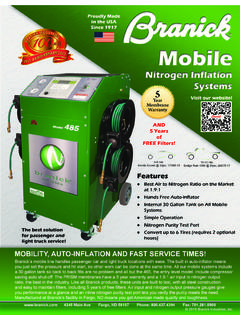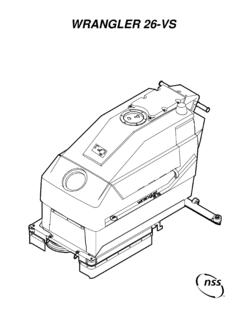Transcription of Installation, Operation MODEL G300 & Repair Parts BRAKE ...
1 installation , Operation MODEL g300 & Repair Parts BRAKE BLEEDER Information Branick Industries, Inc. 4245 Main Avenue Box 1937 Fargo, North Dakota 58103. REV120716 P/N: 81-0035H. THIS PAGE INTENTIONALLY LEFT BLANK. 2. TABLE OF CONTENTS _____. SAFETY INSTRUCTIONS 3. DEFINITIONS 3. SPECIFICATIONS 4. INTENDED USE 4. installation INSTRUCTIONS 4. COMPONENT IDENTIFICATION 5. OPERATING INSTRUCTIONS 6. MAINTENANCE 7. BRAKE BLEEDER Repair Parts 8. ADAPTER Repair Parts 9. ADAPTER INSTRUCTIONS 10. WARRANTY 12. SAFETY INSTRUCTIONS _____. NEVER allow unauthorized personnel to operate this product.
2 NEVER use this product for anything other than its intended use. THOROUGHLY train new employees in the proper use and care of this product. PROHIBIT unauthorized personnel from being in shop area while this product is in use. DEFINITIONS _____. CAUTION: Indicates a potentially hazardous situation, which if not avoided, may result in damage to property or minor personal injury. HAZARD: A source of potential injury to a person. MAINTENANCE: Those actions that preserve the correct and proper conditions under which the machine shall be used. This may include adjustment, replacement of wear items, lubrication and cleaning, but not modifications or Repair of damage.
3 MAY: This word is understood to be permissive. MUST: This word is understood to be mandatory. Operation : The correct and proper use of the machine as described in this manual. SAFETY ALERT SYMBOL: A symbol that indicates a potential personal safety hazard. It is composed of an equilateral triangle surrounding an exclamation point. SHALL: This word is understood to be mandatory. SHOULD: This word is understood to be advisory. WARNING: Indicates a potentially hazardous situation, which if not avoided, may result in death or serious personal injury.
4 3. CAUTION. Before using this product, read and fully understand the operating instructions and all decals on the product. This is necessary to prevent injury to the operator and damage to the product. Do not attempt to use this product for anything other than the intended use. Refer to vehicle service manual for proper bleeding procedure. Do not use Aviation or Hydraulic Fluid with this product. Product damage may result. Avoid allowing BRAKE Fluid to contact vehicle finished surfaces. Damage to the surface finish may result. Always wear appropriate eye protection.
5 SPECIFICATIONS _____. Capacity: 4 gallons Max Air Pressure: 60 5 psi ( .3 bar). Dimensional data (h x w x d): tank only x x . tank and handle 31 x x . Weight: 26 lbs ( kgs). INTENDED USE _____. The g300 BRAKE Bleeder is a pneumatic diaphragm device designed to replace old BRAKE fluid with new while purging air bubbles from automotive hydraulic BRAKE systems. installation INSTRUCTIONS _____. 1. Unpack and remove unit from shipping carton. 2. Inspect unit for any visible damage. 3. To install handle assembly to BRAKE bleeder body; loosen thumb screw on handle receiver, insert handle, and tighten thumb screw to secure handle.
6 4. Install a 1/4 NPT quick coupler nipple to the air inlet on the pressure regulator. 5. Fill with BRAKE fluid following directions in Filling Fluid Reservoir section of OPERATING INSTRUCTIONS. CAUTION. Excessive air pressure can result in serious damage to this diaphragm type BRAKE bleeder. Always follow the vehicle manufacturer's recommendations and never exceed 60 psi. 4. COMPONENT IDENTIFICATION _____. 1. 12. 2. 13. 4. 10 6. 7. 8 9. 14. 3. 11. 5. ITEM DESCRIPTION. _____. 1 Handle 8 Air Purge Valve Assembly 2 Bleeder Hose 9 Bleeder Valve 3 Pressure Gauge 10 Air Inlet Valve 4 Air Inlet 11 Filler Port Adapter 5 Filler Port 12 Safety Relief Valve 6 Reservoir 13 Pressure Regulator 7 Quick Coupler 14 Air Inlet Line _____.
7 5. OPERATING INSTRUCTIONS _____. Filling Fluid Reservoir 1. If connected, disconnect the air line from the air inlet. Open the air inlet valve to allow remaining air to escape (Fig. 1). 2. Remove the bleeder hose from the top of reservoir by unscrewing (counterclockwise) the filler port adapter under the red plastic cap and moving the hose away from the filler port (Fig. 2). 3. If refilling, the internal rubber diaphragm might be inverted inside the tank and must be gently pushed back into place using the handle or a clean blunt instrument inserted through the filler port (Fig.)
8 3). Note: Using a sharp object or too much force can damage the rubber diaphragm. Figure 1 Figure 2 Figure 3. 4. Insert a plastic funnel tightly into the filler port and fill with BRAKE fluid (Fig. 4). If the reservoir overfills and fluid enters the funnel, use the suction syringe to remove any excess. 5. To re-install the bleeder hose on the filler port, place the filler port adapter on the filler port and turn it clockwise. Hand tighten until snug. 6. Check the ball valve on the bleeder hose to ensure it is closed (turn clockwise until it stops).
9 Pressurizing BRAKE Bleeder Note: Maximum pressure is 60 psi. 1. If the air inlet valve is open, close the valve and connect the air line. 2. To adjust the bleeder air pressure, open the air inlet valve, pull down on the regulator knob and turn (Fig. 5) until the desired pressure is shown on the pressure gauge. 3. Insert the air purge valve assembly into the quick coupler on the end of the bleeder hose. 4. Open the bleeder valve and bleed air from the hose and reservoir by opening the purge valve (counter- clockwise) over a container (Fig. 6). This is complete when the fluid produces a smooth steady stream.
10 5. To maintain constant bleeder pressure, leave the air line attached to the regulator. If desired, the air line can be removed from the regulator. Close air inlet valve before removing air line to maintain pressure. Figure 4 Figure 5 Figure 6. 6. BRAKE Bleeding Procedure 1. Refer to vehicle service manual to determine appropriate pressure and adjust accordingly by adding or removing pressure. 2. If a new master cylinder is being installed, bench bleed it before installation . 3. Fill the vehicle master cylinder to its maximum level or approximately below master cylinder reservoir rim.




